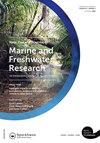使用多尺度大型藻类指数记录新西兰河口的严重富营养化
IF 1.7
4区 环境科学与生态学
Q3 FISHERIES
New Zealand Journal of Marine and Freshwater Research
Pub Date : 2022-07-03
DOI:10.1080/00288330.2022.2093226
引用次数: 2
摘要
摘要新西兰河口的有效管理需要可靠地描述河口对营养物质负荷的营养反应的环境指标。常见的河口富营养化反应是频繁、广泛和持久的机会性大型藻类水华。本研究探讨了机会大型藻类开花工具(OMBT)在新河河口(~4600公顷)的效用,新河河口是新西兰南部牧场集水区内一个以潮间带为主的浅层系统。总氮负荷从3206增加 2000年T y−1至5143 2020年T y−1。同时,使用OMBT测量的机会大型藻类的面积在可用的潮间带栖息地(AIH)从34.9公顷(占AIH的1.4%)扩大到1383公顷(占AIAH的47.6%),平均湿重生物量从19.3增加 g m−2至1326的峰值 g m−2。我们假设,机会性大型藻类在TN负荷随时间增加的直接反应中迅速扩张,而集水区奶牛养殖的扩张和集约化对其增长的贡献不成比例。这项研究证实,OMBT可预测地响应TN浓度的变化,因此可能有助于定义河口特定的TN浓度阈值,以告知实现改善环境结果所需的可能负荷减少。本文章由计算机程序翻译,如有差异,请以英文原文为准。
Use of a multi-metric macroalgal index to document severe eutrophication in a New Zealand estuary
ABSTRACT Environmental indicators that reliably describe estuary trophic response to nutrient loading are required for the effective management of New Zealand estuaries. A common estuary eutrophication response is frequent, extensive and persistent opportunistic macroalgae blooms. This study explores the utility of the Opportunistic Macroalgal Blooming Tool (OMBT) in the New River Estuary (∼4600 ha), a shallow intertidal-dominated system within a pastoral farming catchment in Southland, New Zealand. Total nitrogen (TN) loads increased from 3206 T y−1 in 2000 to 5143 T y−1 in 2020. Concomitantly, areas of opportunistic macroalgae, measured using the OMBT, expanded across the available intertidal habitat (AIH) from 34.9 ha or 1.4% of the AIH to 1383 ha or 47.6% of the AIH, and the average wet weight biomass increased from 19.3 g m−2 to a peak of 1326 g m−2 in 2019. We hypothesise that opportunistic macroalgae expanded rapidly in direct response to temporal increases in TN load, with increases disproportionately contributed by expansion and intensification of dairy farming in the catchment. This study confirmed that the OMBT predictably responded to changes in TN concentration and may therefore be useful in defining estuary-specific TN concentration thresholds to inform likely load reductions required to achieve improved environmental outcomes.
求助全文
通过发布文献求助,成功后即可免费获取论文全文。
去求助
来源期刊
CiteScore
4.50
自引率
12.50%
发文量
35
审稿时长
3 months
期刊介绍:
Aims: The diversity of aquatic environments in the southern continents and oceans is of worldwide interest to researchers and resource managers in research institutions, museums, and other centres. The New Zealand Journal of Marine and Freshwater Research plays an important role in disseminating information on observational, experimental, theoretical and numerical research on the marine, estuarine and freshwater environments of the region.

 求助内容:
求助内容: 应助结果提醒方式:
应助结果提醒方式:


